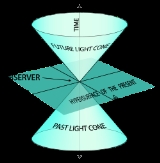
Causal contact
Encyclopedia
Two entities are in causal contact if there may be an event that has affected both in a causal way. Every object of mass
in space
, for instance, exerts a field force
on all other objects of mass, according to Newton's
law of universal gravitation. Because this force exerted by one object affects the motion of the other, it can be said that these two objects are in causal contact.
The only objects not in causal contact are those for which there is no event in the history of the universe that could have sent a beam of light to both. For example, if the universe were not expanding and had existed for 10 billion years, anything more than 10 billion light-years away from the earth would not be in causal contact with it. Anything less than 10 billion light-years away would because an event occurring 10 billion years in the past that was 10 billion light-years away from both the earth and the object under question could have affected both.
 A good illustration of this principle is the Light cone
A good illustration of this principle is the Light cone
:
The light cone is constructed as follows. Taking as event a flash of light (light pulse) at time
a flash of light (light pulse) at time  , all events that can be reached by this pulse from
, all events that can be reached by this pulse from  form the future light cone of
form the future light cone of  , whilst those events that can send a light pulse to
, whilst those events that can send a light pulse to  form the past light cone of
form the past light cone of  .
.
Given an event , the light cone classifies all events in spacetime into 5 distinct categories:
, the light cone classifies all events in spacetime into 5 distinct categories:
See the causal structure of Minkowski spacetime for a more detailed discussion.
Mass
Mass can be defined as a quantitive measure of the resistance an object has to change in its velocity.In physics, mass commonly refers to any of the following three properties of matter, which have been shown experimentally to be equivalent:...
in space
Space
Space is the boundless, three-dimensional extent in which objects and events occur and have relative position and direction. Physical space is often conceived in three linear dimensions, although modern physicists usually consider it, with time, to be part of a boundless four-dimensional continuum...
, for instance, exerts a field force
Force
In physics, a force is any influence that causes an object to undergo a change in speed, a change in direction, or a change in shape. In other words, a force is that which can cause an object with mass to change its velocity , i.e., to accelerate, or which can cause a flexible object to deform...
on all other objects of mass, according to Newton's
Isaac Newton
Sir Isaac Newton PRS was an English physicist, mathematician, astronomer, natural philosopher, alchemist, and theologian, who has been "considered by many to be the greatest and most influential scientist who ever lived."...
law of universal gravitation. Because this force exerted by one object affects the motion of the other, it can be said that these two objects are in causal contact.
The only objects not in causal contact are those for which there is no event in the history of the universe that could have sent a beam of light to both. For example, if the universe were not expanding and had existed for 10 billion years, anything more than 10 billion light-years away from the earth would not be in causal contact with it. Anything less than 10 billion light-years away would because an event occurring 10 billion years in the past that was 10 billion light-years away from both the earth and the object under question could have affected both.

Light cone
A light cone is the path that a flash of light, emanating from a single event and traveling in all directions, would take through spacetime...
:
The light cone is constructed as follows. Taking as event
 a flash of light (light pulse) at time
a flash of light (light pulse) at time  , all events that can be reached by this pulse from
, all events that can be reached by this pulse from  form the future light cone of
form the future light cone of  , whilst those events that can send a light pulse to
, whilst those events that can send a light pulse to  form the past light cone of
form the past light cone of  .
.Given an event
 , the light cone classifies all events in spacetime into 5 distinct categories:
, the light cone classifies all events in spacetime into 5 distinct categories:- Events on the future light cone of
 .
. - Events on the past light cone of
 .
. - Events inside the future light cone of
 are those affected by the beam of light emitted at
are those affected by the beam of light emitted at  .
. - Events inside the past light cone of
 are those that can emit a beam of light and affect what is happening at
are those that can emit a beam of light and affect what is happening at  .
. - All other events are in the (absolute) elsewhere of
 and are those that will never affect and can never be affected by
and are those that will never affect and can never be affected by  .
.
See the causal structure of Minkowski spacetime for a more detailed discussion.

